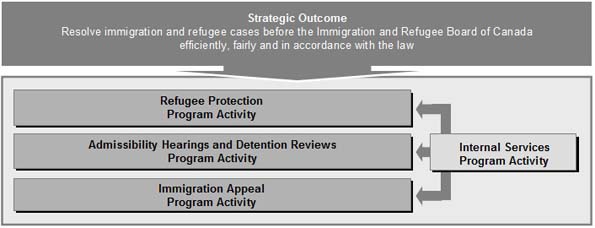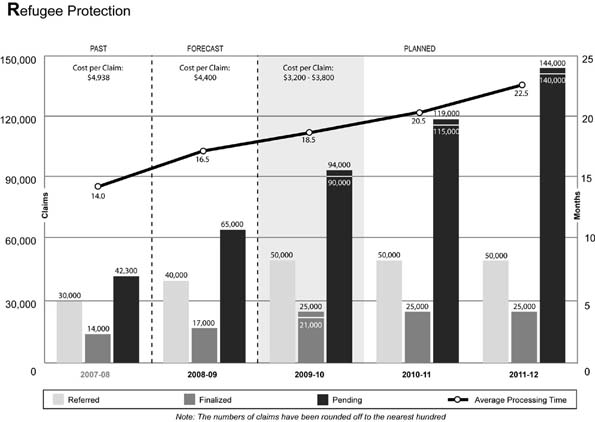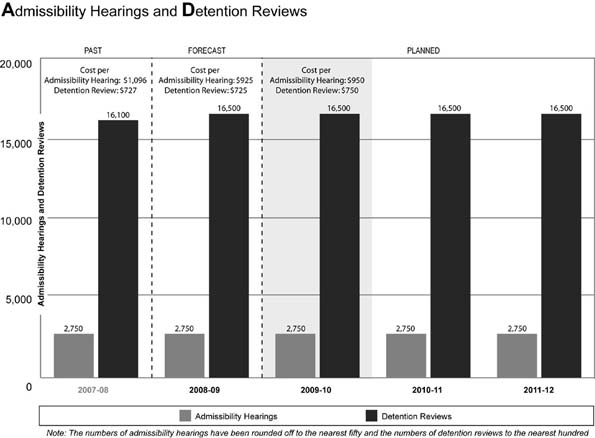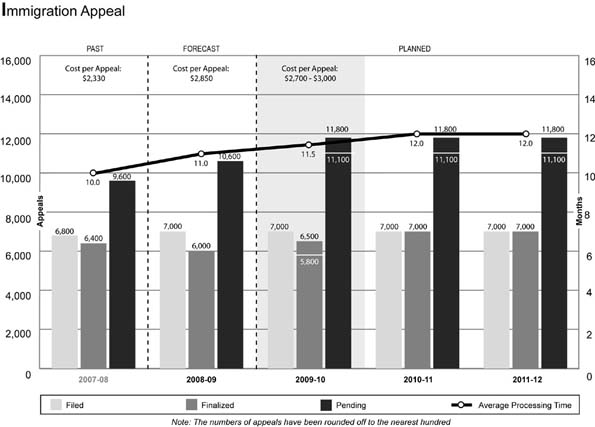Common menu bar links
Breadcrumb Trail
ARCHIVED - Immigration and Refugee Board of Canada
 This page has been archived.
This page has been archived.
Archived Content
Information identified as archived on the Web is for reference, research or recordkeeping purposes. It has not been altered or updated after the date of archiving. Web pages that are archived on the Web are not subject to the Government of Canada Web Standards. As per the Communications Policy of the Government of Canada, you can request alternate formats on the "Contact Us" page.
Section II: Analysis of Program Activities
This section provides detailed information on the plans and expected results as well as financial and human resources for the IRB's four program activities.
Strategic Outcome and Program Activities
As discussed in Section I, based on the IRB's legislated mandate and approved PAA, the IRB has a single strategic outcome and three program activities that include responsibility for all tribunal decisions and resolutions. These are supported by Internal Services, which is the fourth program activity. This section further describes the four program activities.

Program Activity 1
Refugee Protection
| Description The RPD delivers the IRB's Refugee Protection program activity. It determines claims for refugee protection made in Canada. Processing of refugee claims is the main focus of the IRB's activities and resources. Through the work of the RPD, Canada fulfills its obligations as a signatory to a number of international human rights conventions. |
| Fiscal Year | 2009-10 | 2010-11 | 2011-12 |
|---|---|---|---|
| Financial Resources ($ Millions) | 60.3 | 60.1 | 60.0 |
| Human Resources (FTEs) | 591 | 591 | 591 |
| EXPECTED RESULT: Quality decisions rendered and cases resolved in a timely manner regarding refugee protection claims made in Canada | |
|---|---|
| Performance Indicator | Targets |
| Clarity, completeness and conciseness of IRB reasons for decisions | Develop criteria for samples of reasons for decisions. |
| Percentage of cases finalized without a hearing | It is expected that 8% of cases will be finalized without a hearing (expedited process). |
| Ratio of finalized cases to referred cases | Approximately 50,000 refugee protection claim referrals are expected to be received in 2009-10. Based on the number of decision-makers available we expect to finalize between 21,000 and 25,000 claims. This will result in a ratio of finalized to referred cases of 42% to 50%. |
| Average cost per claim finalized | The average cost per finalized claim will be between $3,200 and $3,800 depending on the number of claims finalized. |
| Average case processing time | Based on the inventory and the available decision-maker complement, it is expected that the average processing time (from referral to finalization) could increase to 18.5 months. |

(Click on image to enlarge)
2009-10 Planning Highlights
Further increase capacity to resolve cases and manage the case inventory. The RPD depends on experienced, highly trained decision-makers to provide well reasoned quality decisions in a timely manner. Throughout 2008-09 the RPD operated with approximately 40 fewer decision-makers than its funded level. Between 2007-08 and December 2008 the RPD lost 26 experienced decision-makers due to expired mandates, resignations, or reappointments not being made. The Board will continue to actively recruit for new decision-makers and train appointees to develop the experienced decision-making capacity in the RPD.
The RPD expects to begin the fiscal year with a pending inventory of approximately 65,000 cases. The division expects to receive an additional 50,000 new refugee claim referrals in 2009-10. Depending on the number of the decision-makers available and their level of experience, the RPD expects to have the capacity to finalize between 21,000 and 25,000 claims. Therefore, the pending inventory is projected to reach between 90,000 and 94,000 by the end of 2009-10.
Strengthen relationships with partners and stakeholders. The RPD will continue to use national and regional consultative processes to engage stakeholders and partners in order to find practical solutions to decrease the inventory and develop efficiencies in case management.
Continue to build an integrated, flexible and effective organization. The RPD will enhance certain operational functions and training initiatives and develop new ways to enhance case management processes such as streaming case types for expedited processing and training public service employees to review certain cases and provide recommendations to decision-makers. The RPD remains committed to maintaining the high standard of decision-making that has earned its refugee determination process international recognition as one of the best in the world.
Benefits for Canadians
Through the work of the Refugee Protection program activity, Canada accepts only those refugee claimants in need of protection. Canada provides a safe haven to persons with a well-founded fear of persecution, as well as to those who face a danger of torture or a risk to their life or a risk of cruel and unusual treatment or punishment. This contributes to a safe and secure world environment through international cooperation.
Program Activity 2
Admissibility Hearings and Detention Reviews
| Description The ID delivers the Admissibility Hearings and Detention Reviews program activity. It holds hearings for foreign nationals or permanent residents who, under the provisions of the IRPA, are alleged to be inadmissible to Canada or are detained. Detainees must be seen by the Immigration Division within 48 hours after their referral, and subsequent reviews must be conducted within specific statutory timeframes. Decision-makers must balance the right to individual liberty with the security interests of Canadians. |
| Fiscal Year | 2009-10 | 2010-11 | 2011-12 |
|---|---|---|---|
| Financial Resources ($ Millions) | 11.4 | 11.4 | 11.4 |
| Human Resources (FTEs) | 63 | 63 | 63 |
| EXPECTED RESULT: Quality decisions rendered and cases resolved in a timely manner regarding admissibility hearings and detention reviews | |
|---|---|
| Performance Indicator | Targets |
| Clarity, completeness and conciseness of IRB reasons for decisions | Develop criteria for samples of reasons for decisions. |
| Percentage of admissibility hearing cases concluded to referred cases | 90-95% (Detention Reviews take priority over Admissibility Hearings due to legislative time requirements. The number of referrals from the CBSA will affect the capacity to conduct Admissibility Hearings.) |
| Percentage of concluded detention review cases within statutory timeframe | 97% (Factors outside the IRB's control, such as prison lock-down, impede the achievement of 100% compliance.) |
| Average cost of admissibility hearing | $950 |
| Average cost of detention review | $750 |
| Percentage of admissibility hearings concluded with a hearing within six months from referral | 86-88% (Detention Reviews take priority over Admissibility Hearings due to legislative time requirements. The number of referrals from the CBSA will affect the capacity to conduct Admissibility Hearings.) |

(Click on image to enlarge)
2009-10 Planning Highlights
Further increase capacity to resolve cases and manage the case inventory. The number of cases concluded by the ID depends on the number of cases referred by the CBSA. Over the past four years, referrals of admissibility hearings have increased by 23% while referrals of detention reviews have increased by 21%. Through enhanced efficiencies, the ID has managed the increased workload within existing resources and has been able to conclude cases within the legislated timeframe for detention reviews.
It is anticipated that the ID will continue to experience a moderate increase in referrals for admissibility hearings, while the number of detention reviews will remain high but stable. The ID will continue to prioritize detention reviews to ensure that legislative requirements and fundamental rights are respected.
In order to manage its case inventory, the ID will develop and implement case management standards. It is expected that more efficient case management will result in reduced adjournment and postponement rates, shorter processing times and increased capacity to resolve cases.
Strengthen relationships with partners and stakeholders. The ID will engage stakeholders and partners to seek their input on operational efficiencies. The ID will work with the CBSA to coordinate resources and ensure that cases are concluded rapidly and in a fair and cost effective manner.
Continue to build an integrated, flexible and effective organization. Quality standards will be developed in concert with the other program activities to ensure the delivery of well-reasoned decisions. Efficiency standards will be developed in conjunction with the Operations Branch. The focus will be on reducing the number of admissibility hearings that are pending for more than six months and finalizing the majority of new cases within this six-month timeframe.
Benefits for Canadians
The ID renders decisions that maintain the security of Canadian society and uphold Canada's reputation for justice and fairness to individuals. It is with this sense of responsibility that the IRB maintains the balance between individual rights and the security of the Canadian population throughout Canada's communities.
Program Activity 3
Immigration Appeal
| Description The IAD delivers the Immigration Appeal program activity. It hears immigration appeals from Canadian citizens and permanent residents whose applications to sponsor close family members to Canada have been refused. Other key functions include hearing appeals from permanent residents, foreign nationals with a permanent resident visa and protected persons who have been ordered removed from Canada, and permanent residents outside Canada who have not fulfilled their residency obligation. |
| Fiscal Year | 2009-10 | 2010-11 | 2011-12 |
|---|---|---|---|
| Financial Resources ($ Millions) | 13.2 | 13.2 | 13.1 |
| Human Resources (FTEs) | 115 | 115 | 115 |
| EXPECTED RESULT: Quality decisions rendered and cases resolved in a timely manner regarding immigration appeals | |
|---|---|
| Performance Indicator | Targets |
| Clarity, completeness and conciseness of IRB reasons for decisions | Develop criteria for samples of reasons for decisions. |
| Percentage of appeals finalized without a hearing | It is expected that 45% or more of appeals will be finalized without a hearing. |
| Ratio of finalized appeals to filed appeals | Approximately 7,000 appeals are expected to be filed in 2009-10. Based on the number of decision-makers available, we expect to finalize between 5,800 and 6,500 appeals. This will result in a ratio of finalized to filed appeals of 83% to 93%. |
| Average cost per appeal finalized | The average cost per appeal finalized will be between $2,700 and $3,000 depending on the number of appeals finalized. |
| Average appeal processing time | Based on the inventory and the available decision-maker complement, it is expected that the average processing time could increase to 11.5 months in 2009-10. |

(Click on image to enlarge)
2009-10 Planning Highlights
Last year, the IAD experienced an average shortfall of 24% in decision-makers. Nevertheless, the IAD continues to build successful procedural, adjudicative and administrative practices that increase its efficiency, productivity and fairness.
Further increase capacity to resolve cases and manage the case inventory. The IAD will manage its caseload through innovative and effective case management and adjudication strategies that promote best practices and cross-regional consistency. These strategies will focus on early resolution without a hearing (including alternative dispute resolution), hearing readiness, proactive hearings and quality decisions that are made in a timely manner.
Strengthen relationships with partners and stakeholders. The IAD will continue to work closely with appellants' counsel groups as part of both national and regional IAD consultative committees as well as other avenues to share information and solicit cooperation in meeting common goals. The IAD will continue to work with the CBSA to quickly finalize appeals that the CBSA has screened for early resolution and facilitate the hearing of appeals where the Minister's counsel's has chosen to participate through written submissions only.
Continue to build an integrated, flexible and effective organization. The IAD will continue to respond flexibly to match resources with regional caseloads by sharing decision-makers among regions and by conducting hearings via videoconference. Tribunal officers and registry office staff will continue to work closely with members and member managers to provide effective adjudicative support and to resolve appeals without a hearing where possible.
Benefits for Canadians
Through the sponsorship appeals work, the IAD recognizes the contributions of immigrants to the strength and vitality of Canadian society and culture, as well as the Government's commitment to family reunification. Through the removal order appeals work, the IAD recognizes the consequences of the decisions it makes with respect to enhancing public safety while balancing this with individual rights.
Program Activity 4
Internal Services
| Description Internal Services are groups of related activities and resources required to support the needs of all three tribunal programs and other corporate obligations of the IRB. These services are: Management and Oversight; Communications; Legal; Human Resources Management; Financial Management; Information Management; Information Technology; Materiel; Acquisition; and Other Administrative Services. Internal Services include only those activities and resources that apply across an organization and not to those provided to a specific program. |
| Fiscal Year | 2009-10 | 2010-11 | 2011-12 |
|---|---|---|---|
| Financial Resources ($ Millions) | 28.5 | 28.4 | 28.3 |
| Human Resources (FTEs) | 257 | 257 | 257 |
2009-10 Planning Highlights
Management and oversight. At the end of the previous reporting period, the IRB restructured its advisory committees and created an independent audit committee. In 2009-10, the IRB will implement the Chief Financial Officer model in accordance with the new Policy on Financial Management Governance. These changes will improve senior management decision-making support and enhance oversight for the Board's activities.
Communications. The IRB will continue to improve understanding of its mandate and role, share best practices and find opportunities to collaborate with national and international partners as well as non-governmental organizations, other tribunals, parliamentarians, the media, the public and counsel through its communications and outreach efforts.
Legal. Legal Services will focus its activities on providing training and support to new decision-makers and offering advice, including risk analysis, regarding innovative adjudicative strategies and their implementation in support of the Board's inventory management. Legal Services will work to ensure that the various aspects of operations, service delivery, policy development, corporate direction and management decisions are in compliance with all relevant legal requirements.
Human Resources management. The IRB will continue to foster an environment where people management is valued and recognized as a priority in achieving its strategic outcome. The IRB recognizes that training for its decision makers and adjudicative support staff is crucial to maintaining and enhancing the quality of its core business of resolving, hearing and deciding cases. The IRB will focus on the implementation of a talent management initiative and on strengthening continuous learning and professional development initiatives for decision-makers and public service employees in order to optimize the potential of the Board's human capital and achieve the broader goals of the Government's Public Service Renewal Action Plan.
Financial management. The IRB will focus its efforts on implementing the new suite of Treasury Board Secretariat (TBS) financial policies and directives. This will include impact analysis, amendments to existing internal processes and practices, communications and training.
Information management. The information management focus will be on implementing a new IRB function-based classification structure and on providing support and guidance to senior management on this and other related information management matters.
Information technology. The IRB, in accordance with its three-year strategic information technology plan, will focus on the planning and tactical deployment of process improvement strategies to ensure stronger internal and external business partnerships. In addition, we will continue ongoing maintenance and support of existing information systems and develop new solutions to meet business needs.
Procurement and assets management. The IRB will continue to strengthen its procurement functions through regular training sessions. We will improve internal processes in order to further eliminate duplication of effort. In addition, we will implement new asset management policies and procedures in order to enable effective, efficient, accountable and environmentally responsible activities related to the life-cycle management of IRB assets.
Internal audit and evaluation. The IRB will implement the new Government-wide Audit Policy and support the recently created IRB Audit Committee. The IRB will match its capacity to conduct audits and internal evaluations with the needs for continuous monitoring of IRB operations to provide senior management with improved information for decision-making, provide assurances regarding governance, risk management, stewardship and accountability, and improve overall management oversight.
